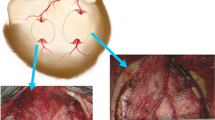Summary
Background. To establish multiple bypass flow in an adult Moyamoya disease patient, the distal stump of the parietal superficial temporal artery (dsPSTA) was used as an additional donor.
Methods. Its potential as the donor was first evaluated by measuring the arterial pressure directly in three patients, revealing about 80% in mean arterial pressure of those measured at the proximal stump and radial artery. The anastomosis was performed just as conventionally except an additional anastomosis between the dsPSTA and frontal branch of the middle cerebral artery in 10 hemispheres of 7 patients.
Results. The patency of the dsPSTA bypass was confirmed on postoperative angiography in 5 patients. The comparison of pre- and post-operative single photon emission computed tomography was feasible in 8 hemispheres of 6 patients of which 7 demonstrated improvement of the cerebral blood flow.
Conclusion. This technique provides a novel source of donor artery in the treatment of Moyamoya disease, in which multiple anastomoses are desirable.
Similar content being viewed by others
References
K Houkin T Ishikawa T Yoshimoto H Abe (1997) ArticleTitleDirect and indirect revascularization for Moyamoya disease surgical techniques and peri-operative complications Clin Neurol Neurosurg 99 IssueIDSuppl 2 142–145
K Houkin S Kuroda T Ishikawa H Abe (2000) ArticleTitleNeovascularization (angiogenesis) after revascularization in Moyamoya disease. Which technique is most useful for Moyamoya disease? Acta Neurochir (Wien) 142 269–276 Occurrence Handle10.1007/s007010050035 Occurrence Handle1:STN:280:DC%2BD3c3nslersA%3D%3D
A Ikeda I Yamamoto O Sato N Morota T Tsuji T Seguchi (1991) ArticleTitleRevascularization of the calcarine artery in moyamoya disease: OA-cortical PCA anastomosis – case report Neurol Med Chir 31 658–661 Occurrence Handle1:STN:280:DyaK383ksVChtw%3D%3D
T Iwama (2006) ArticleTitleSurgical treatment for Moyamoya disease: the point and pitfall in practice No Shinkei Geka 34 557–564 Occurrence Handle16768131
T Iwama N Hashimoto H Miyake Y Yonekawa (1998) ArticleTitleDirect revascularization to the anterior cerebral artery territory in patients with moyamoya disease: report of five cases Neurosurgery 42 1157–1161 Occurrence Handle9588563 Occurrence Handle10.1097/00006123-199805000-00124 Occurrence Handle1:STN:280:DyaK1c3ksl2ktQ%3D%3D
N Khan B Schuknecht E Boltshauser A Capone A Buck HG Imhof Y Yonekawa (2003) ArticleTitleMoyamoya disease and Moyamoya syndrome: experience in Europe; choice of revascularisation procedures Acta Neurochir (Wien) 145 1061–1071 Occurrence Handle10.1007/s00701-003-0148-5 Occurrence Handle1:STN:280:DC%2BD3srotFGisg%3D%3D
H Kilinc BT Bilen (2006) ArticleTitleA new approach to retroauricular flap transfer: parietal branch-based reverse flow superior auricular artery island flap Ann Plast Surg 56 380–383 Occurrence Handle16557067 Occurrence Handle10.1097/01.sap.0000202147.15402.50 Occurrence Handle1:CAS:528:DC%2BD28XhtlGrtLbO
PC Neligan H She-Yue PJ Gullane (1997) ArticleTitleReverse flow as an option in microvascular recipient anastomoses Plast Reconstr Surg 100 1780–1785 Occurrence Handle9393476 Occurrence Handle10.1097/00006534-199712000-00021 Occurrence Handle1:STN:280:DyaK1c%2FlsFWqtg%3D%3D
CV Reis S Safavi-Abbasi JM Zabramski SN Gusmao RF Spetzler MC Preul (2006) ArticleTitleThe history of neurosurgical procedures for moyamoya disease Neurosurg Focus 20 E7 Occurrence Handle16819815 Occurrence Handle10.3171/foc.2006.20.6.7
ER Smith RM Scott (2005) ArticleTitleSurgical management of Moyamoya syndrome Skull Base 15 15–26 Occurrence Handle16148981 Occurrence Handle10.1055/s-2005-868160
AL Stock HP Collins TM Davidson (1980) ArticleTitleAnatomy of the superficial temporal artery Head Neck Surg 2 466–469 Occurrence Handle7390853 Occurrence Handle10.1002/hed.2890020604 Occurrence Handle1:STN:280:DyaL3c3islegtw%3D%3D
S Takeuchi H Kikuchi J Karasawa S Yamagata I Nagata (1989) ArticleTitleRegional cortical blood flow during extra-intracranial bypass surgery in young patients with moyamoya disease Neurol Med Chir 29 10–14 Occurrence Handle1:STN:280:DyaL1M3psFyiuw%3D%3D Occurrence Handle10.2176/nmc.29.10
Author information
Authors and Affiliations
Rights and permissions
About this article
Cite this article
Taniguchi, M., Taki, T., Tsuzuki, T. et al. EC-IC bypass using the distal stump of the superficial temporal artery as an additional collateral source of blood flow in patients with Moyamoya disease. Acta Neurochir (Wien) 149, 393–398 (2007). https://doi.org/10.1007/s00701-006-1098-5
Received:
Accepted:
Published:
Issue Date:
DOI: https://doi.org/10.1007/s00701-006-1098-5




